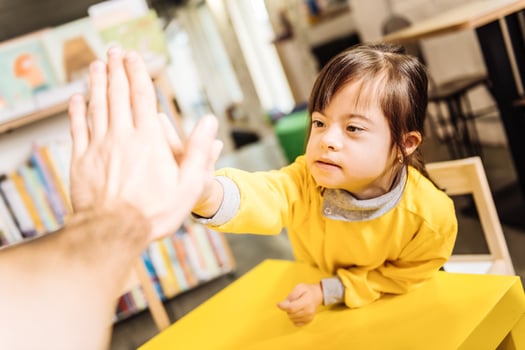Falling Through the Cracks: Better Identification and Integrated Treatment for Autistic or Other Special Needs ELL Students
Research indicates that ELL students who should be classified with disability status are being overlooked. The good news is that increasingly, educators are integrating ELL and special education services in a culturally responsive manner. As training programs for both teachers and mental health providers encourage a broader worldview, there appears to be progress in understanding the needs of students and in integrating services. The ARIS® Academic Readiness Intervention System curriculum, referenced below, provides a comprehensive solution for language and behavior learning for any child struggling with language and behavioral issues.
Background: Silos for ELL vs. Special Needs Students
English Language Learners (ELLs) will make up 25% of all students by the year 2025, according to the US Department of Education. At the same time, students requiring disability services comprise roughly 8% of the school population.1 Historically, teachers have either been trained to teach ELL or to teach special needs students. Separate silos. Different needs dictate the provision of different services for each group. Or do they? Let’s take a closer look at the issues and current solutions.
What Are the Issues?
The three major issues addressed here are
1) Language learning for students with a primary language other than English
2) The importance of accurate and timely diagnoses of learning disabilities or disorders
3) A social justice approach to culturally appropriate provision of services.

1. Language Learning
Facility with the English language is an important foundation for achieving academic success in U.S. schools, but it is certainly not the only component. Mainstream educators should be aware of the myriad factors that affect second-language acquisition, according to author Judie Haynes; these factors may be both individual and contextual:
- A newcomer who exhibits disruptive or odd behavior may be suffering from culture shock, not a behavioral or emotional disorder.
- ELLs need comprehensible input. They cannot learn English by “soaking up” language in a mainstream classroom; they need to both hear and understand.
- To acquire a new language, children need a source of natural communication. Memorizing grammar rules will not help them learn to speak and write English quickly.
- The emotional state of ELLs affects how they acquire a new language. ELLs need a comfortable, safe environment in which to learn.
- Newcomers will go through a silent period during which they will not speak. They should not be forced to speak until they are ready.2
2. Disability Diagnoses
A meta-analysis of 72 studies found evidence that ethnic minority youth with learning disabilities or disorders may be misdiagnosed or not diagnosed at all.3 Certainly an accurate diagnosis of autism spectrum disorder (ASD), or any other disorder, is essential to determining accurate treatment and methods to meet educational needs.
Differences in racial/ethnic culturally-influenced parenting practices may have implications for involvement -- or the lack thereof -- with the mental health system that would be necessary for accurate diagnosis. What one parent might believe is a problematic behavior or developmental delay, consistent with their worldview, might be considered not a problem by another parent with a different worldview.
Further complicating matters is potential bias on the part of clinicians responsible for diagnosing disorders. While the DSM-54 added a cultural formulation to help clinicians ask appropriate questions in a diagnostic interview, some may not use this tool, and the use of the tool does not in itself make for a culturally competent clinician.

3. Social Justice
Who gets referred for ELL or disability services, and why? Historically, there has been at least the assumption of an overrepresentation of ethnic and racial minorities referred to special education. For example, Native Alaskan children are taught that it is disrespectful to give direct eye contact to authority figures, such as teachers; thus, they gaze away from the adult speaking to them. This is often misinterpreted as disengagement, disrespect, or lack of comprehension. Students from Asian cultures are used to a receptive learning environment, where students only speak when spoken to by the teacher, and raising hands or shouting out responses is inappropriate. Teachers from Western cultures may incorrectly assume that these students don’t know the answers or don’t understand the material. Silence may be misinterpreted as a cognitive deficit.
Recent research, however, indicates that the assumption of overrepresentation of minority students in special education is simply not valid. Specifically, a 2015 study found that:
From kindergarten entry to at least the end of middle school, racial and ethnic minority children are less likely than otherwise similar white children to be identified as having (a) learning disabilities, (b) speech or language impairments, (c) intellectual disabilities, (d) health impairments, or (d) emotional disturbances. Language minority children are less likely to be identified as having (a) specific learning disabilities or (b) speech or language impairments.5
What this suggests is an underrepresentation; that is, students who perhaps should be classified with disability status, are being overlooked. How are these approaches to referral for diagnosis, treatment, and instruction working? Not well, according to various researchers. Although strides have been made over the past few decades on both fronts, there remains a relative lack of sufficiently sophisticated evidence-based problem-solving in both diagnosis and instruction.
What Are the Approaches?
The “silos” approach dictates that these two intersecting endeavors run parallel operations; that is, ELL instruction focuses only on that, and diagnosis and amelioration of learning disabilities and disorders focuses only on that. Unfortunately, this does a disservice to the students who are both ELLs and also have a learning disability or disorder. Addressing language-learning needs, and ASD needs, in a socially-just manner is a complex undertaking.
An Integrated Service-Delivery Model
Increasingly, educators are integrating ELL and special education in a culturally competent manner. As training programs for both teachers and mental health providers encourage a broader worldview, there appears to be progress in understanding the needs of students and in integrating services. The first step to this progress was recognizing that the silo approach was ineffective. One might be tempted to think that a failure to request assessment for disorders with ELLs was either intentional or the result of incompetence; however, that appears to rarely be the case. Interestingly, Kangas found that there was a delay in referring ELL students for assessment from Kindergarten through third grade because teachers wanted to be non-judgmental and give ELLs the opportunity to show what they could do; unfortunately, the ELLs with undiagnosed disorders then fell further behind because they did not receive timely assessment and the specialized services that might have helped them catch up.7
Instead of silos, we need to build interconnected webs of services to meet the complex needs of autistic children and families who are seeking effective English language instruction. Increased cultural competence on the part of service providers is one piece of the puzzle; delivering instructional services that are research-based is another key element. One such delivery system is the ARIS Academic Readiness Intervention System from STAGES® Learning, designed specifically for autistic children from pre-school through elementary grades.
ARIS8 is based on recent research from UCLA and Harvard educators and curriculum specialists. It includes specific components aimed at language learning, with multiple modules designed to meet the specific needs of autistic children. The design was built on the model of Applied Behavior Analysis (ABA), which is familiar to most families of autistic students. To meet the social justice component of a favorable model, Stages Learning makes a vast array of support materials available for free to teachers, parents, and other service providers. And best of all, ARIS is simple to use and FUN! The ARIS curriculum empowers parents, educators, and other service providers to quickly and easily begin utilizing this hands-on system immediately. It achieves the goal of integrating the essential components of a successful learning product that meets the needs of autistic students who are also ELLs. Win-win!

References
1. Kangas, S. N. (2014) When Special Education Trumps ESL: An Investigation of Service Delivery for ELLs with Disabilities, Critical Inquiry in Language Studies, 11:4, 273-306, DOI: 10.1080/15427587.2014.968070
2. Haynes, J. (2007). Getting Started with English Language Learners: How Educators Can Meet the Challenge. Association for Supervision and Curriculum Development. Alexandria VA. ISBN-13: 978-1416605195
3. Liang, J., Matheson, B. E., & Douglas, J. M. (2016). Mental Health Diagnostic Considerations in Racial/Ethnic Minority Youth. Journal of child and family studies, 25(6), 1926–1940. https://doi.org/10.1007/s10826-015-0351-z
4. Diagnostic and Statistical Manual of Mental Disorders, 5th edition.
5. Morgan, P. L., Farkas, G., Hillemeier, M. M., Mattison, R., Maczuga, S., Li, H., & Cook, M. (2015). Minorities are Disproportionately Underrepresented in Special Education: Longitudinal Evidence Across Five Disability Conditions. Educational researcher (Washington, D.C. : 1972), 44(5), 278–292. https://doi.org/10.3102/0013189X15591157
6. Blatchley, L. and Lau, M. (2010). Culturally Competent Assessment of English Language Learners for Special Education Services. Communiqué: May 2010, Volume 38, Number 7 8. National Association of School Psychologists.
7. Kangas op. cit.
8. For more information on ARIS, please go to: https://blog.stageslearning.com/blog/a-new-curriculum-for-autism-aris

Signe M. Kastberg
Signe M. Kastberg is a licensed mental health counselor with a PhD in Human Development. She taught and directed a Master’s degree program in Mental Health Counseling. She is a psychotherapist, consultant, author, certified in personality typology and is a board-certified clinical sexologist.




